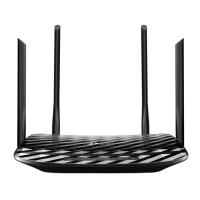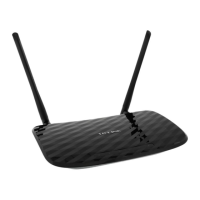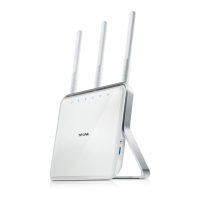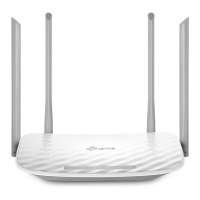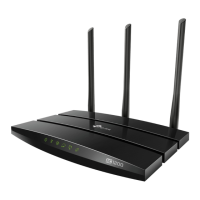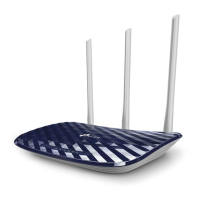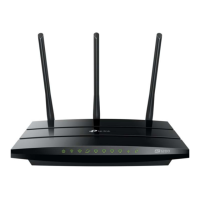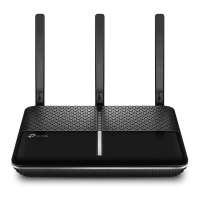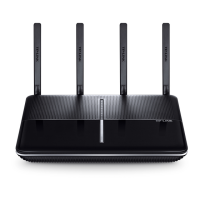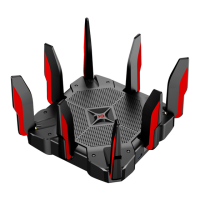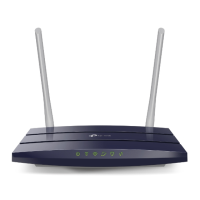Do you have a question about the TP-Link Archer C7 AC1750 and is the answer not in the manual?
Details the router's features, speed, security, and ease of installation.
Lists the key technical specifications and capabilities of the Archer C7 router.
Describes the router's front and rear panels, LEDs, and ports.
Lists necessary hardware and software for router setup and operation.
Provides step-by-step instructions for physically connecting the router to the modem and PC.
Configure PC TCP/IP settings and verify network connection to the router.
Guides users through the initial web-based setup wizard for basic router configuration.
Access the router's web interface using default credentials.
View current router operational status, firmware, and network information.
Guided initial setup for the router, covered in Chapter 3.
Configure WAN, LAN, MAC Clone, and IPTV settings for network connectivity.
Choose between 2.4GHz, 5GHz, or concurrent wireless operation.
Configure basic wireless parameters for the 2.4GHz band (SSID, security, etc.).
Configure basic wireless parameters for the 5GHz band (SSID, security, etc.).
Allows setting up a separate wireless network for guests.
Configure DHCP server for automatic IP address assignment.
Configure USB settings for storage devices or printers.
Configure NAT, port forwarding, virtual servers, DMZ, and UPnP.
Configure firewall, VPN passthrough, and advanced security features.
Control internet access, limiting websites and time spent online.
Set up rules to manage internet access based on hosts, targets, and schedules.
Configure static routes and view the system routing table.
Manage network bandwidth by setting control settings and rules.
Bind IP addresses to MAC addresses to prevent unauthorized access.
Configure Dynamic DNS services for remote access to network resources.
Configure IPv6 network settings.
Utilities for managing time, diagnostics, firmware, logs, and statistics.
Update the router's firmware for new features and fixes.
Restore the router's configuration settings to their original factory defaults.
Change the router's default administrator username and password.
Log out of the router's web-based management interface.
Steps to configure the router for ADSL internet access using PPPoE.
Steps to configure for Ethernet internet access, including MAC cloning.
Configure Virtual Server, DMZ Host, and H323 ALG for Netmeeting.
Steps to set up a web server on the LAN, avoiding port conflicts.
Guide to installing and configuring TCP/IP components in Windows XP.
Details the router's features, speed, security, and ease of installation.
Lists the key technical specifications and capabilities of the Archer C7 router.
Describes the router's front and rear panels, LEDs, and ports.
Lists necessary hardware and software for router setup and operation.
Provides step-by-step instructions for physically connecting the router to the modem and PC.
Configure PC TCP/IP settings and verify network connection to the router.
Guides users through the initial web-based setup wizard for basic router configuration.
Access the router's web interface using default credentials.
View current router operational status, firmware, and network information.
Guided initial setup for the router, covered in Chapter 3.
Configure WAN, LAN, MAC Clone, and IPTV settings for network connectivity.
Choose between 2.4GHz, 5GHz, or concurrent wireless operation.
Configure basic wireless parameters for the 2.4GHz band (SSID, security, etc.).
Configure basic wireless parameters for the 5GHz band (SSID, security, etc.).
Allows setting up a separate wireless network for guests.
Configure DHCP server for automatic IP address assignment.
Configure USB settings for storage devices or printers.
Configure NAT, port forwarding, virtual servers, DMZ, and UPnP.
Configure firewall, VPN passthrough, and advanced security features.
Control internet access, limiting websites and time spent online.
Set up rules to manage internet access based on hosts, targets, and schedules.
Configure static routes and view the system routing table.
Manage network bandwidth by setting control settings and rules.
Bind IP addresses to MAC addresses to prevent unauthorized access.
Configure Dynamic DNS services for remote access to network resources.
Configure IPv6 network settings.
Utilities for managing time, diagnostics, firmware, logs, and statistics.
Update the router's firmware for new features and fixes.
Restore the router's configuration settings to their original factory defaults.
Change the router's default administrator username and password.
Log out of the router's web-based management interface.
Steps to configure the router for ADSL internet access using PPPoE.
Steps to configure for Ethernet internet access, including MAC cloning.
Configure Virtual Server, DMZ Host, and H323 ALG for Netmeeting.
Steps to set up a web server on the LAN, avoiding port conflicts.
Guide to installing and configuring TCP/IP components in Windows XP.
| Ethernet Ports | 4 x Gigabit LAN, 1 x Gigabit WAN |
|---|---|
| Memory | 128MB RAM, 16MB Flash |
| Wireless Standard | IEEE 802.11ac/n/a 5GHz, IEEE 802.11b/g/n 2.4GHz |
| Frequency Band | 2.4 GHz, 5 GHz |
| Wi-Fi Speed | 450Mbps at 2.4GHz, 1300Mbps at 5GHz |
| USB Ports | 1 x USB 2.0 |
| Antennas | 3 external detachable antennas |
| Security | 64/128-bit WEP, WPA/WPA2, WPA-PSK/WPA2-PSK |
| Dimensions | 9.6 x 6.4 x 1.3 in (243 x 160.6 x 32.5 mm) |
| Weight | 0.93 lbs (0.42 kg) |
